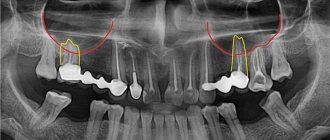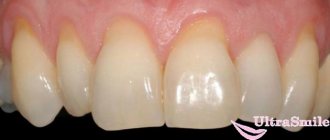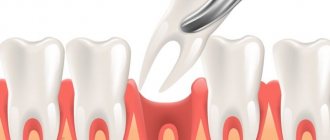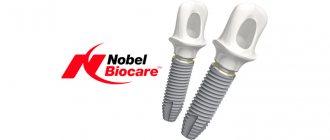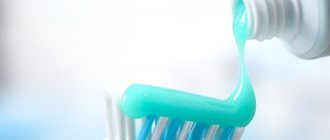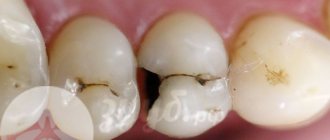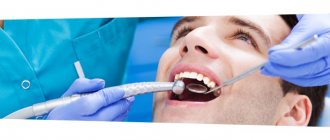2801
Some patients visit dentists because they have a tooth that has already formed in the oral cavity, but for a number of reasons has not erupted.
In most cases, its position does not cause any discomfort, but at the same time others think that the person does not have a tooth in its usual place.
Less common, but possible, is the appearance of purulent processes that can lead to serious consequences.
To prevent future problems, medicine suggests performing orthodontic traction on the problem unit.
The essence of the technique
When pulling a tooth, it can not only be moved vertically, but also tilted in the desired direction.
This is possible due to a number of anatomical features of the structure of the root part of the organ, as well as due to the use of a certain force. Experts strive for the appearance of so-called pressure zones, which ensure the occurrence of histological changes.
It is necessary to understand that this procedure cannot be carried out in several sessions. As practice shows, it takes several months to finally restore the normal physiological position.
Although there are exceptions for some patients. One of the main factors determining the speed of this process is the age of the patient.
Question answer
Is it always possible to use braces to move teeth to the place where they were removed?
If one tooth is missing, you can do without implantation. But usually this is only possible if there is a shortage of chewing units (provided there is sufficient bone tissue). They differ little in function and form. If there are missing front teeth, implantation will be required. Frontal units vary in size and shape; their displacement will cause an aesthetic defect in the smile area.
Levin Dmitry Valerievich
Maxillofacial surgeon, chief physician of the Center
Indications and contraindications
Indications include the following:
- genetic features of development;
- early process of changing milk units;
- the course of vitamin deficiency;
- unnatural jaw development;
- the presence of somatic weakness;
- carrying out prosthetics or removal of problem units without following the established schedule.
The procedure is not carried out if there is no free space to move the element of the jaw row, there are no neighbors near the damaged unit, or when the intracanal pin is difficult to install.
Find out reviews from patients after orthognathic surgery about the complexity and pain of the procedure.
Come here to find out if you can get braces if you have crowns.
At this address https://orto-info.ru/sistemyi-vyiravnivaniya-zubov/breketyi/kak-mozhno-tselovatsya-otkrovenno-o-sokrovennom.html we will tell you how to kiss with braces.
The result of orthodontic treatment
As a result of treatment at Dial-Dent, the semi-impacted tooth was preserved and placed in its place in the dentition. All teeth became straight:
A year and a half after fixing the braces, an excellent treatment result was achieved. The peculiarity of this work was the return (and not removal!) of an incorrectly growing semi-impacted tooth into the dentition. High aesthetics and functionality have been achieved.
The cost of treatment was 230,100 rubles. Find out the current cost of treatment during a consultation with an orthodontist.
See other examples of bite correction and teeth alignment here.
Basics of conducting
To carry out the procedure in question, diagnostics and preparation are required, after which the problem tooth is pulled out.
Once the process is completed, the patient will have to wait for some time, periodically checking with a dentist.
Identification of the defect location
The main objective of the presented procedure is to bring the defect site to an optimal position, located above the alveolar gum or ridge. This way you can restore the damaged element while maintaining the normal state of the periodontium.
It takes two to three visits to move a unit. First, the doctor carefully dissects the periodontal fibers and restores the normal position of the root. Next, the periodontal fibers take root in the resulting position.
Diagnostics
The essence of the diagnosis comes down to taking an x-ray, after which you can understand whether retention is present, at what angle the impacted element is cut, and in what sector of eruption it is located at the time of inspection.
Computed tomography allows you to most accurately determine the location and further possibility of carrying out the procedure.
It should also be noted that if the diagnostic results reveal the presence of an impacted canine tooth resting on the root of neighboring units, the patient will have to prepare for the loss of all of them.
The reason for this is the possibility of eating the roots of neighboring units that are located at an unnatural angle.
Preparation
The specialist inserts a pin into the inner part of the root, the end of which is equipped with a hook. Next, you need to install a wire “crossbar” on the adjacent teeth.
Using a special elastic band, the root is “suspended” to the resulting crossbar. Thanks to the traction that appears, the tooth is pulled out from the inner space of the gum.
Sometimes patients are embarrassed by the results of the preparation. To hide all defects during the recovery period, specialists create a composite veneer, which covers the treated area.
Carrying out
The procedure for carrying out such an operation includes two stages. At the first stage, a corresponding place is created in the jaw row, and at the second stage, the impacted element is brought into the desired position.
In most cases, the operation is performed with mandatory exposure of the crown.
The technique includes four main stages:
- The crown of the problematic element is completely exposed.
- A lock is installed on adjacent units, including the defective one.
- Using elastic traction, the impacted canine is pulled out.
- The canine is further extended using an elastic arch.
Let's figure out together what you can't eat with braces on your teeth and how to eat properly.
In this publication, read what an initial orthodontic consultation for children includes.
Here https://orto-info.ru/ortodonticheskoe-lechenie/osnovnoy-period/brekety-i-karies.html all the most important things about the causes of caries from braces.
Traction of an impacted tooth
Diagnostics
Again, the diagnostic procedure is carried out using computed tomography. It allows you to check at what angle the defective area is located and what the next steps will be for comprehensive treatment.
On average, diagnosis takes from 5 to 10 minutes, depending on what kind of computed tomography is performed.
Preparation
Before the procedure is carried out, it is necessary to completely cure all teeth. The technique is also applicable to molars, but in this case the possibility of furcation exposure cannot be excluded. This, in turn, can reduce the lifespan of the restored unit.
Immediately before the operation, the specialist must administer local anesthesia. Surgeries are possible only if the patient’s condition allows them to begin work (the area of the oral cavity being treated is fully prepared for surgery).
Carrying out
The essence of the technique is as follows:
- Using orthodontic forceps.
- Installation of a pin with a special loop before cementing it in a specially designated channel.
- Installation of a bracket that is completely adapted to the hard tissues located in the adjacent space.
- Cementing the pin in the canal with subsequent fixation of the bracket to the elements of the jaw row located nearby.
- Installation of elastic fiber.
- Installation of a fixed elastic cord followed by fibrotomy.
- Relocation of the problematic root, seven days later.
Complications
Both before and after the operation, the doctor must familiarize the patient with how to behave correctly for the fastest and highest quality recovery.
When moving, the tooth has to move for a long time, turning in parallel by a certain number of degrees.
If all instructions are followed correctly, the process will not take long. On the other hand, neglecting the rules and forcing events leads to potential complications, for example, bone tissue will begin to resorb, which will negatively affect the roots.
It is possible that in the future it will be necessary to completely remove both the problematic element and the neighboring ones, since they are in close contact with the deformed area with their base.
The video presents one of the orthodontic tooth traction techniques.
Why extrusion is needed
Most often, this clinical picture is observed in the canine area. It is not always clear to the patient why such complex treatment is necessary to pull a tooth out of the gums if it does not interfere or cause pain. Experts know that impacted elements, especially in the frontal part of the dental arch, remain unchanged up to a certain point, but in the process of full development of the skull they can become active and gradually change position, causing a worsening of the clinical picture.
With incomplete retention, inflammation of the adjacent soft tissues of the gums often occurs, including purulent inflammation. With complete retention (lying in the jaw), strong pressure is exerted on the adjacent roots, so over time, the elements adjacent to the incisor can, under the force of pressure, change position and become crooked, move to the side, etc.
Often such an exacerbation is combined with fever, a feeling of pressure and pain in the jaw, neuralgia, etc. If you refuse to pull from the gums, the following pathologies may develop:
- cyst;
- deep caries and pulpitis;
- periostitis;
- purulent lymphadenitis;
- inflammation of the trigeminal nerve;
- abscess;
- phlegmon;
- malocclusion, etc.
Advantages and disadvantages of technology
When performing orthodontic tooth traction, it is possible to prevent preparations that are located in the vicinity. The need to create removable dentures/bridges is also avoided.
This is of great importance, especially when adjacent units are covered with a high-quality metal-ceramic crown, which could be removed for subsequent bridge production. The client does not have to pay extra money.
It is also worth noting that the original contour of the nearby soft tissue is completely preserved, which is very important in terms of aesthetics.
Therefore, the main candidates for this procedure are dental office visitors who do not want to completely remove the root and replace it with an implant.
The disadvantage of the technique is that the gum, the area of which is located in the impacted tooth, begins its recession.
If the periodontal junction is damaged when the crown is exposed, the root that needs to be moved will have to be significantly exposed. This, in turn, is considered a blunder.
Types of location of an impacted tooth
| Fine | The tooth has a vertical position and grows upward very slowly. Baby teeth and canines can grow properly. “Wisdom teeth” are rarely positioned normally. |
| Horizontally | The impacted tooth forms a right angle to the healthy one, located horizontally. This situation is detrimental to a healthy “neighbor”. In such a situation, it is necessary to remove the impacted tooth, which is performed only surgically. |
| Obliquely | An impacted tooth grows at an angle toward the cheek or tongue. If such an anomaly does not cause inconvenience to a person, then removal is not necessary. |
Expected effect
The tooth is pulled out using a specially installed system. Although the procedure occurs without any pain, you should prepare in advance for the fact that you will have to spend a lot of time.
As practice shows, it takes an average of 3-4 months to restore milk units, while for older patients it can last up to nine months.
When determining the amount of time required for treatment, the complexity of the individual case and the current condition of the oral cavity as a whole are taken into account. With the help of a chain, the doctor completely extends the element with every millimeter.
The end result is complete extension of the tooth. The best option is when a third party is shown the results of treatment without telling him about the fact of the procedure, and at the same time he does not understand what the differences are between a normal and an extraordinary situation.
In other words, the result is of high quality only when the tooth is fully extended to return to its normal physiological position.
The operating time of the elongated element may also vary depending on the condition it was in at the time of treatment.
It is extremely important to prevent the development of any diseases, as well as to cope with existing pathologies. Otherwise, the patient risks encountering complications in the form of infection in the treated area and nearby units.
In terms of time of use, the treated molar will be no different from the rest. The main thing is to adhere to the rules of personal hygiene and constantly monitor the appearance of signs of the disease.
But this will be prevented by regular visits to the dentist. One way or another, you will still have to regularly go to the dental office, because doctors need to fully control the recovery process.
What is cheaper - braces or implants with crowns?
Both methods cost approximately the same price.
In our Center, the cost of implantation consists of 3 items:
- Surgical stage. Provides manipulations for the introduction of a titanium pin with the inclusion of the necessary materials and services of an implantologist in the price. Cost - 65-85 thousand rubles.
- Crown installation. When the implant takes root, a crown is installed on it. Its price ranges from 48 to 55 thousand rubles, depending on the production technology.
- Bone growth. If the bone tissue is thinning, it will require preliminary extension, which will cost from 24 thousand rubles.
Total: the cost of implanting one tooth is from 137 thousand rubles.
During orthodontic treatment to replace one dental unit, row correction involves installing braces on both jaws. Options and combinations of designs differ, which is why the price ranges from 62-127 thousand rubles per jaw (the most expensive are made from sapphire). When installing braces on both jaws, the price doubles.
Total: to install the cheapest braces on both jaws you will need 124 thousand rubles.
Surgery
Recommendations after removal
On the first day:
- Do not consume hot food and drinks;
- Do not drink alcoholic beverages;
- Refrain from smoking;
- Do not rinse your mouth;
- Do not apply hot compresses;
- Do not take a hot bath.
During the recovery period we recommend:
- Avoid intense physical activity;
- Take prescribed medications;
- To reduce pain, apply cold compresses and take painkillers.
Our specialists
Kozulev Evgeniy Viktorovich
Pediatric dentist
Okhotin Dmitry Alekseevich
General practice
Vasiliev Vasily Vyacheslavovich
Surgeon
Kudzieva Diana Ruslanovna
Therapist
Minaeva Ekaterina Anatolevna
Pediatric dentist
We employ experienced dental surgeons. Modern equipment and individual approach to patients. Surgical dentistry, where you can perform tooth extraction in adults and children at affordable prices:
- Kalininsky district (metro Lenin Square, Vyborgskaya, Lesnaya) Kondratyevsky Prospekt, 48. How to get there
- Kurortny district, Sestroretsk, Volodarskogo street, 3. Dental clinic How to get there
Make an appointment: +7 (812) 670-62-70
Diagnostics
A semi-retained tooth is easily detected: its tip is visible above the gum, and its contours are determined by palpation.
A completely impacted tooth cannot always be detected during routine examination; impaction can be assumed based on the long-term failure of the permanent tooth to erupt. Definitive diagnosis is possible only after an X-ray examination. Carry out:
- targeted radiography - the image is taken on a limited area of the jaw, allows you to assess the condition of 3-4 teeth;
- orthopantomography - a survey x-ray, on it you can see the condition of the teeth and tissues of both jaws.
To make the right decision on further treatment, a computed tomography scan is often required - using a special device, the doctor receives a layer-by-layer image of the jaw. The resulting images can be combined into a 3D image, which makes it possible to make an accurate diagnosis and determine the position of the impacted tooth relative to other teeth. Computed tomography is indispensable in the diagnosis of supernumerary impacted teeth, the detection of which using conventional x-ray examination may be difficult due to the overlay of their image on the contours of permanent teeth.
In children, a sign of retention is the prolonged absence of replacement of a baby tooth with a permanent one.
